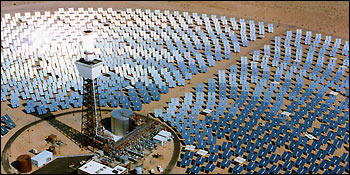
|
Solar, Wind and Hydropower
According to online sources, “Solar energy is the light and radiant heat from the Sun that influences Earth's climate and weather and sustains life. Solar power is sometimes used as a synonym for solar energy or more specifically to refer to electricity generated from solar radiation. Since ancient times solar energy has been harnessed by humans using a range of technologies. Solar radiation along with secondary solar resources such as wind and wave power, hydroelectricity and biomass account for most of the available renewable energy on Earth.
Solar energy refers primarily to the use of solar radiation for practical ends. All other renewable energies other than geothermal derive their energy from energy received from the sun.
Solar technologies are broadly characterized as either passive or active depending on the way they capture, convert and distribute sunlight. Active solar techniques use photovoltaic panels, pumps, and fans to convert sunlight into useful outputs. Passive solar techniques include selecting materials with favorable thermal properties, designing spaces that naturally circulate air, and referencing the position of a building to the Sun. Active solar technologies increase the supply of energy and are considered supply side technologies, while passive solar technologies reduce the need for alternate resources and are generally considered demand side technologies.”
| Yearly Solar Fluxes & Human Energy Consumption | |
| Solar | 3,850,000 EJ |
| Wind | 2,250 EJ |
| Biomass | 3,000 EJ |
| Electricity (2005) | 56.7 EJ |
| Primary energy use (2005) | 487 EJ |
The difficulty with solar power is that it is an intermittent supply of energy: every night the energy supply goes to bed. That is where wind and hydropower come into play. Also, for now, direct conversion of solar energy to electricity is not terribly efficient. Strides are being made every year to improve the efficiencies, but we’re not there yet. The benefits of solar power, however, are great. The distributive nature of solar power helps reduce the need for extensive and complex electrical distribution networks. It also reduces the demand on power plants during the daytime when power plants experience their peak demands.
References
Tune in Monday for Part 19 of SEatWtC!












